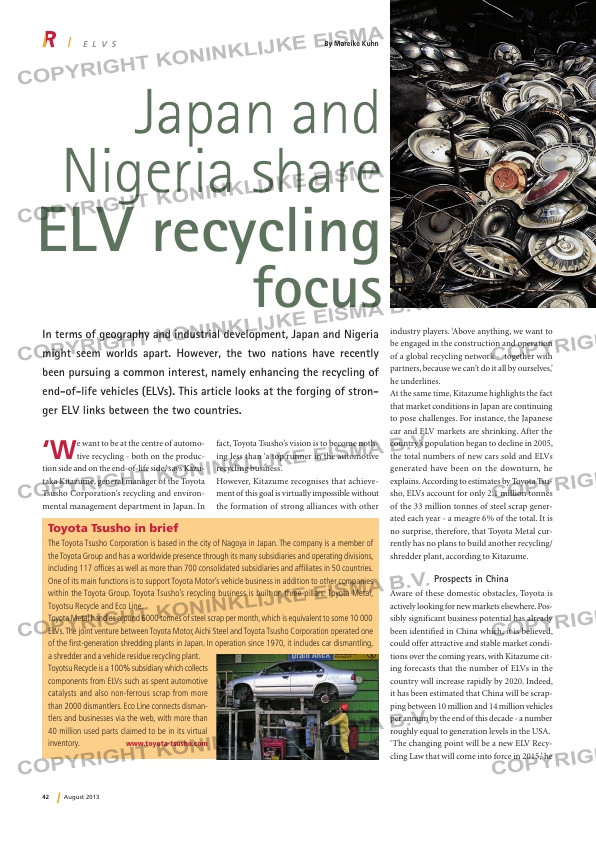Page 42 from: August 2013

42 August 2013
‘We want to be at the centre of automo-tive recycling – both on the produc-
tion side and on the end-of-life side,’ says Kazu-
taka Kitazume, general manager of the Toyota
Tsusho Corporation’s recycling and environ-
mental management department in Japan. In
fact, Toyota Tsusho’s vision is to become noth-
ing less than ‘a top runner in the automotive
recycling business’.
However, Kitazume recognises that achieve-
ment of this goal is virtually impossible without
the formation of strong alliances with other
industry players. ‘Above anything, we want to
be engaged in the construction and operation
of a global recycling network – together with
partners, because we can’t do it all by ourselves,’
he underlines.
At the same time, Kitazume highlights the fact
that market conditions in Japan are continuing
to pose challenges. For instance, the Japanese
car and ELV markets are shrinking. After the
country’s population began to decline in 2005,
the total numbers of new cars sold and ELVs
generated have been on the downturn, he
explains. According to estimates by Toyota Tsu-
sho, ELVs account for only 2.1 million tonnes
of the 33 million tonnes of steel scrap gener-
ated each year – a meagre 6% of the total. It is
no surprise, therefore, that Toyota Metal cur-
rently has no plans to build another recycling/
shredder plant, according to Kitazume.
Prospects in China
Aware of these domestic obstacles, Toyota is
actively looking for new markets elsewhere. Pos-
sibly significant business potential has already
been identified in China which, it is believed,
could offer attractive and stable market condi-
tions over the coming years, with Kitazume cit-
ing forecasts that the number of ELVs in the
country will increase rapidly by 2020. Indeed,
it has been estimated that China will be scrap-
ping between 10 million and 14 million vehicles
per annum by the end of this decade – a number
roughly equal to generation levels in the USA.
‘The changing point will be a new ELV Recy-
cling Law that will come into force in 2015,’ he
E L V s By Mareike Kuhn
Toyota Tsusho in brief
The Toyota Tsusho Corporation is based in the city of Nagoya in Japan. The company is a member of
the Toyota Group and has a worldwide presence through its many subsidiaries and operating divisions,
including 117 offices as well as more than 700 consolidated subsidiaries and affiliates in 50 countries.
One of its main functions is to support Toyota Motor’s vehicle business in addition to other companies
within the Toyota Group. Toyota Tsusho’s recycling business is built on three pillars: Toyota Metal,
Toyotsu Recycle and Eco Line.
Toyota Metal handles around 6000 tonnes of steel scrap per month, which is equivalent to some 10 000
ELVs. The joint venture between Toyota Motor, Aichi Steel and Toyota Tsusho Corporation operated one
of the first-generation shredding plants in Japan. In operation since 1970, it includes car dismantling,
a shredder and a vehicle residue recycling plant.
Toyotsu Recycle is a 100% subsidiary which collects
components from ELVs such as spent automotive
catalysts and also non-ferrous scrap from more
than 2000 dismantlers. Eco Line connects disman-
tlers and businesses via the web, with more than
40 million used parts claimed to be in its virtual
inventory. www.toyota-tsusho.com
In terms of geography and industrial development, Japan and Nigeria
might seem worlds apart. However, the two nations have recently
been pursuing a common interest, namely enhancing the recycling of
end-of-life vehicles (ELVs). This article looks at the forging of stron-
ger ELV links between the two countries.
Japan and
Nigeria share
ELV recycling
focus
RI-6_ELV.indd 42 01-08-13 11:48



